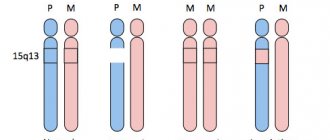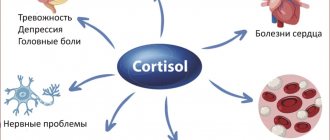What is hypothalamic syndrome?
Hypothalamic syndrome is a symptom complex of damage to the hypothalamic region, characterized by autonomic, endocrine, metabolic and trophic disorders.
Various stressful situations, psychotraumatic effects, intoxication, traumatic brain injuries, vascular diseases, tumors, acute infections (influenza, ARVI (ARI), pneumonia, viral neuroinfections), chronic infections (cholecystitis, sinusitis, tonsillitis) play a significant role in the occurrence of hypothalamic syndrome. , rheumatism, tuberculosis). Increased vascular permeability of the hypothalamus can facilitate the penetration of toxins and viruses from the blood into the brain, and displacement of cerebrospinal fluid during traumatic brain injury can cause hypothalamic dysfunction. The occurrence of hypothalamic syndrome is also facilitated by hereditary and acquired constitutional defects of the hypothalamus and closely related structures of the limbic-reticular complex (limbic system and reticular formation) and the pituitary gland. Often, the pathological course of pregnancy and childbirth can be one of the factors of improper formation and maturation of the hypothalamus at various stages of fetal ontogenesis.
Sympathoadrenal crisis
Sympathoadrenal crisis in hypothalamic syndrome is manifested by severe headache, pain in the heart, palpitations, a feeling of fear, palpitations, a feeling of fear, difficulty breathing, numbness of the extremities. During a crisis, the skin is pale, dry, blood pressure (BP) is elevated, there may be slight hyperthermia (37.0; 37.1; 37.2; 37.3; 37.4; 37.5; 37.6; 37.8 ; 37.9 degrees Celsius), dilated pupils, increased erythrocyte sedimentation rate (reaction) (ESR, ROE), hyperglycemia (increased blood glucose levels). The attack often ends with chills, frequent urination (pollakiuria) or a single copious discharge of urine (polyuria).
Diagnostics
Due to the numerous symptoms of hypothalamic syndrome, its diagnosis presents certain difficulties.
Various tests are used to make a diagnosis
- determination of the sugar curve with load: measuring blood sugar on an empty stomach and after taking 100 g. glucose with sugar determination every 30 minutes,
- three-day urine test according to Zimnitsky,
- measurement of body temperature at three points: in both armpits and in the rectum,
- electroencephalography.
Shown
- appointment of MRI of the brain (detection of increased intracranial pressure and tumor),
- study of hormones (testosterone, prolactin, cortisol, estradiol, FSH, TSH, adrenocorticotropic hormone and the level of 17-ketosteroids in the urine),
- Ultrasound of the adrenal glands and thyroid gland
- MRI of the adrenal glands or computed tomography.
Neuroendocrine-metabolic form | Hypothalamic syndrome
The neuroendocrine-metabolic form of the hypothalamic syndrome is characterized mainly by endocrine disorders due to loss or increased secretion of hormones of the anterior pituitary gland.
The following diseases may occur.
Diabetes insipidus
1) diabetes insipidus (polyuria, polydipsia, dry mouth, general weakness);
Adiposogenital dystrophy
2) adiposogenital dystrophy - Pechkranz-Babinsky-Fröhlich syndrome (nutritional obesity, increased appetite, hypogenitalism, general weakness, various endocrine disorders);
Frontal hyperostosis
3) frontal hyperostosis - Morgagni-Stewart-Morel syndrome (hyperostosis of the internal plate of the frontal bone, amenorrhea, obesity, virilism);
Juvenile basophilism
4) juvenile basophilism - prepubertal basophilism (obesity, increased blood pressure / arterial hypertension /, stretch marks / stretch marks / on the skin;
Pituitary cachexia
5) pituitary cachexia - hypothalamic-pituitary cachexia, panhypopituitarism, Simmonds syndrome (rapid decrease in body weight by 1.5 - 2 times with the development of cachexia / exhaustion /;
Malignant exophthalmos
6) malignant exophthalmos - exophthalmic ophthalmoplegia (slowly progressive exophthalmos without thyrotoxicosis, at first it can be one-sided, oculomotor disorders, more often external ophthalmoplegia, diplopia, possible keratitis, atrophy of the optic discs);
Precocious puberty
7) premature puberty (pubertas praecox) - more often manifested in girls by the early development of secondary sexual characteristics, often combined with the following symptoms: high growth, bulimia, polydipsia, polyuria, sleep disturbance (insomnia), changes in the emotional-volitional sphere / children become rude, cruel, evil, have a tendency towards vagrancy, theft, antisocial violations/;
Delayed puberty
 delayed puberty – occurs mainly in boys during adolescence and is manifested by female-type obesity, hypogenitalism, lethargy, and decreased initiative;
delayed puberty – occurs mainly in boys during adolescence and is manifested by female-type obesity, hypogenitalism, lethargy, and decreased initiative;
Gigantism
9) gigantism is a disease that is characterized by the presence in adolescents and children of open epiphyseal growth zones with excessive secretion of self-tropic hormone (STH), height in boys and young men reaches more than 200 cm, and in girls and women more than 190 cm;
Acromegaly
10) acromegaly - Marie syndrome, or Marie-Lery syndrome - is a neuroendocrine syndrome caused by a significant increase in the secretion of somatotropic hormone of the anterior pituitary gland; the syndrome was first described in 1886 by P. Marie; and in most cases it is associated with an eosinophilic pituitary adenoma, sometimes acromegaly can develop after traumatic brain injury, intoxication, infection, stressful conditions; there is an increase in the size of the hands, feet, facial skeleton, nose, tongue, ears, and internal organs;
Dwarfism, dwarfism
11) nanism / dwarfism / - (nanos - dwarf) is a clinical syndrome manifested by extremely short stature (compared to the gender and age norm), occurs relatively often, causing mental distress in both the child and his parents, especially against the background acceleration in other children, often manifests itself in combination with other developmental defects (hydrocephalus, microcephaly, mental retardation, eye changes), in patients with chromosomal syndromes (Down disease, where, along with dwarfism, there are multiple developmental anomalies);
Itsenko-Cushing's disease
12) Itsenko-Cushing's disease (pituitary basophilism, Cushing's disease) develops due to excessive release of adrenocorticotropic hormone (ACTH) by the pituitary gland; first described by N. M. Itsenko and H. W. Cushing; occurs more often with basophilic pituitary adenoma, traumatic brain injury, inflammatory diseases of the brain, long-term use of large doses of corticosteroids or ACTH, manifested by symptoms of hypercortisolism (uneven obesity, moon-shaped face, fat deposits in the neck, upper half of the body, skin trophic disorders, osteoporosis , increased blood pressure, amyotrophy in the proximal limbs, intracranial hypertension, pyramidal and brainstem symptoms);
Lawrence-Moon-Bardet-Biedl syndrome
13) Lawrence-Moon-Bardet-Biedl syndrome is a hereditary diencephalic-retinal pathology, which includes Lawrence-Moon syndrome (first described in 1866 by JZ Laurence and R. Ch. Moon) and Bardet-Biedl syndrome (first described by G. Bardet in 1920 and A. Biedl in 1922), the type of inheritance is autosomal recessive and polygenic determination, the main symptoms of Lawrence-Moon syndrome are mental retardation, pigmentary retinopathy, hypogenitalism, spastic paraplegia, Bardet-Biedl syndrome - mental retardation, pigmentary retinopathy, hypogenitalism, obesity, polydactyly.
Impaired thermoregulation, hypothalamic syndrome with impaired thermoregulation
Violation of thermoregulation of hypothalamic origin most often manifests itself in the form of prolonged low-grade fever, against the background of which hyperthermic crises sometimes occur with an increase in body temperature to 38.0 - 38.5 - 39.0 degrees Celsius. Unlike an increase in temperature during infectious diseases (diseases), this hyperthermia has a number of features and differences: an increase in temperature in the morning and a decrease in the evening, its relatively good tolerance, no changes in the blood and urine, a negative amidopyrine test, a perverted thermoregulatory Shcherbak reflex (with normal thermoregulation rectal temperature increases by 0.5 degrees Celsius after immersing hands in water at a temperature of 32 degrees and gradually increasing it to 42 degrees). Violation of thermoregulation can also manifest itself as hypothermia and poor tolerance to drafts, weather changes, and low temperatures.
Treatment of endocrine obesity
First of all, it is necessary to eliminate the root cause of obesity - specific hormonal dysfunction. For example, using hormone replacement therapy. Otherwise, the principles of treatment are similar to those given above.
A huge role is played by the patient’s motivation to get rid of the disease and awareness of its psychological causes. Therefore, psychotherapeutic assistance is not excluded.
Traditional medicine methods (instead of or together with classical ones) can also be used in the treatment of people suffering from obesity. Acupuncture, classical and resonant homeopathy, osteopathy, qigong therapy and herbal medicine have a holistic effect on a person, helping his body find and implement the optimal way to overcome the disease.
Make an appointment
Neurotrophic form
The neurotrophic form includes various trophic disorders due to damage to the hypothalamus: trophic ulcers, focal or diffuse edema of different parts of the body (especially in combination with vegetative-vascular crises), brittle nails, osteoporosis, osteodystrophy, some types of alopecia /hair loss/. In its pure form, the neurotrophic form is rare, and trophic disorders are included in the structure of other forms of hypothalamic syndrome, more often in the neuroendocrine-metabolic form.
Neuromuscular form, catalepsy, narcolepsy | Hypothalamic syndrome
The neuromuscular form is manifested by general weakness, adynamia, and transient atypical attacks of catalepsy. Catalepsy (affective adynamia, emotional asthenia, affective loss of muscle tone, Levenfeld-Enneberg syndrome) is a short-term, paroxysmal loss of muscle tone, which occurs more often with strong emotional influences and leads to the patient falling without loss of consciousness. Catalepsy is a symptom of narcolepsy. Narcolepsy (Gelino's disease) is a disease from the group of hypersomnias, characterized by attacks of irresistible drowsiness and falling asleep during the daytime. Neurologists and neuropathologists distinguish essential narcolepsy, which occurs without visible external influences, and symptomatic narcolepsy, which occurs after infections, epidemic encephalitis, traumatic brain injuries, tumors of the 3rd ventricle, pituitary gland, internal hydrocephalus. Attacks of drowsiness occur suddenly, often in inappropriate conditions: while eating, walking, talking, urinating. The attacks usually last for several minutes. Depending on the external manifestations, neurologists distinguish 2 forms of narcolepsy: monosymptomatic, which is manifested only by attacks of falling asleep, and polysymptomatic, which is manifested by attacks of falling asleep, catalepsy, night sleep disturbances, and hypnogogic hallucinations.
Hallucinations, Pickwissky syndrome, Kleine–Lewin syndrome
Hallucinations are false perceptions without a real object. Neuropathologists , neuropsychiatrists and psychiatrists distinguish between visual, auditory, olfactory, gustatory, tactile, and general senses. Hallucinations that occur while falling asleep are called hypnagogic. Hallucinations that occur upon awakening are called hypnopompic hallucinations. Movement disorders in the neuromuscular form of hypothalamic origin, they do not have a clear clinical picture and delineation, they are very variable, unstable, fragmented, and prone to paroxysmal progression. This same form includes some forms of phenocopies of neuromuscular diseases. Disturbances in sleep and wakefulness can be manifested by changes in the sleep formula (drowsiness during the day and insomnia at night), hypersomnia, narcolepsy, periodic hibernation syndrome, which is characterized by sleep attacks lasting from several hours to several weeks. At this time, muscle hypotonia, areflexia, arterial hypotension, and lack of control over the activity of the pelvic organs occur. More complex syndromes of sleep and wakefulness disorders may also be observed: Pickwickian syndrome , Kleine–Lewin syndrome. Pickwickian syndrome is a pathological condition of obesity in small people, manifested by shallow breathing, arterial hypertension (increased blood pressure), shortness of breath, drowsiness and general weakness. Kleine–Lewin syndrome is characterized by attacks of sleepiness with bulimia.
Clinical forms of hypothalamic syndrome rarely occur in isolated form. Thus, vegetative-vascular (vegetative-vascular) crises can be observed in neuroses, diseases of internal organs, vegetative-vascular dystonia (vegetative-vascular dystonia). Neuroendocrine metabolic disorders occur in other pathological processes of non-hypothalamic localization, as well as in primary endocrine diseases.
Diagnosis
The diagnosis is based on a carefully collected anamnesis and on a number of objective data from a neurological and therapeutic examination, as well as on data from a study of autonomic functions, biochemical studies of blood and cerebrospinal fluid and electrophysiological studies (EEG, chronaximetry, oscillography). First of all, it is necessary to exclude diseases of the internal organs and paranasal cavities. Ultraviolet erythema in patients with G. s. often depressed and less often irritative and depends on the severity of the disease (and the form of the syndrome). In patients with G. s. There is an asymmetry of temperature in the axillary region, often low-grade fever. It is important to simultaneously study the temperature in the axillary region and rectal temperature - normally, the rectal temperature is 0.5-0.7° higher, and with G. s. there is either isothermia, or the difference reaches 1.0-1.5°. The McClure-Aldrich hydrophilic test (see McClure-Aldrich test) in most patients accelerates the resorption of the papule and, less often, slows it down, which indicates a disorder of water metabolism. In 2/3 of patients, the basal metabolism is often increased. Data on carbohydrate metabolism are especially important. The blood sugar curve in most patients is altered. An increase in alpha globulins and a decrease in beta globulins in the blood serum are detected. During sympathetic-adrenal crises, there is an increased content of total adrenaline and a high level of catecholamines in the blood, and during vago-insular crises: - low levels of adrenaline and acetylcholine. The Zimnitsky test often reveals nocturia. Electroencephalography data (see) with G. s. give clear patol changes in a significant number of patients, but their correlation with one or another form of the syndrome is not always possible. Chronaximetric data (see Chronaximetry) indicate pathology of the central, suprasegmental apparatuses, which is reflected in the chronaxy indicators of nerves and muscles. With the help of oscillographic and plethysmographic studies (see Oscillography, Plethysmography) vegetative-vascular instability is detected.
Diagnosis of neuroendocrine disorders in patients with G. s. often presents significant difficulties, since in diseases of the endocrine glands, secondary hypothalamic disorders can be observed. In these cases, differential diagnosis should be based on studying the dynamics of the development of individual symptoms and the severity of the entire wedge, the picture as a whole. Neuroendocrine disorders in G. s., as a rule, are much less pronounced than in primary lesions of the endocrine glands.
How to treat hypothalamic syndrome, how to get rid of hypothalamic syndrome!
Comprehensive differentiated treatment of patients with hypothalamic syndrome with the widespread use of effective techniques allows one to achieve good results even with severe symptoms.
At the first consultation, the doctor will tell you about the main factors and symptoms of the disease: what is hypothalamic syndrome in newborns, children, adolescents, adults (men and women), what is mild, moderate, severe hypothalamic pubertal juvenile neuroendocrine syndrome (neuroendocrine form) How the army, Wikipedia and obesity are related to hypothalamic syndrome.
Sign up for a consultation. There are contraindications. Specialist consultation is required. Photo: Dgm007 | Dreamstime.com\Dreamstock.ru. The people depicted in the photo are models, do not suffer from the diseases described and/or all similarities are excluded.
Related posts:
Neuralgia and neuritis, intercostal neuralgia: symptoms, treatment in Saratov
Insomnia, treatment of insomnia in Saratov, what to do for insomnia
Hypothalamic syndrome, treatment of hypothalamic syndrome, how to treat
Enuresis, bedwetting in children, treatment, child peeing at night
Depression, treatment of depression, how to get out of depression in Saratov
Comments ()
Our services
The administration of CELT JSC regularly updates the price list posted on the clinic’s website. However, in order to avoid possible misunderstandings, we ask you to clarify the cost of services by phone: +7
| Service name | Price in rubles |
| Appointment with an obstetrician-gynecologist with ultrasound examination (primary) | 4 200 |
| Endoscopic ovarian resection | 95 000 — 125 000 |
All services
Make an appointment through the application or by calling +7 +7 We work every day:
- Monday—Friday: 8.00—20.00
- Saturday: 8.00–18.00
- Sunday is a day off
The nearest metro and MCC stations to the clinic:
- Highway of Enthusiasts or Perovo
- Partisan
- Enthusiast Highway
Driving directions








